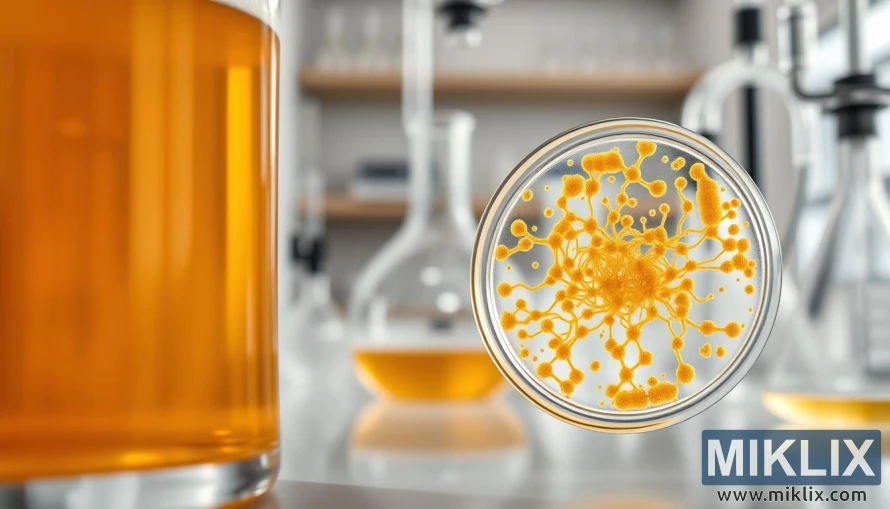Image: Yeast Sensory Profile in Lab
Published: August 16, 2025 at 8:42:15 PM UTC
Last updated: September 27, 2025 at 11:48:40 PM UTC
A modern lab scene with a beaker of golden beer, yeast sample in a petri dish, and scientific tools, highlighting yeast sensory analysis.
In this richly detailed laboratory scene, the viewer is invited into a space where microbiology and sensory science converge in a symphony of precision and curiosity. The image is composed with a deliberate elegance, capturing the essence of yeast culture and its role in fermentation through a blend of visual clarity and atmospheric warmth. The lighting is soft and diffused, casting a gentle glow across the workspace and highlighting the textures and colors of the materials in play. This subtle illumination creates a sense of calm and focus, ideal for the meticulous work being conducted.
Dominating the foreground is a glass beaker filled with a golden-hued liquid—most likely a freshly brewed beer or fermentation sample. The clarity of the liquid and the way it catches the light suggest a well-filtered product, rich in malt character and possibly infused with caramel undertones. Though the aroma cannot be captured visually, the image evokes a sensory experience: the warmth of toasted grains, the sweetness of residual sugars, and the faint tang of fermentation. The beaker’s placement and prominence signal its importance in the process, perhaps representing the final product or a test batch undergoing sensory evaluation.
Just behind the beaker, the focal point shifts to a petri dish held delicately in the hand or mounted for observation. Within the dish, a colony of yeast blooms in a striking radial pattern, its orange pigmentation suggesting a specialized strain or a reaction to specific growth media. The branching structure of the colony is intricate and organic, resembling the fractal-like spread of fungal hyphae or bacterial filaments. This visual complexity hints at the dynamic nature of microbial life—how it adapts, expands, and interacts with its environment. The petri dish is positioned to allow close inspection, possibly under a microscope lens, inviting the viewer to consider the cellular architecture and metabolic behavior of the yeast strain.
In the background, the laboratory unfolds in a blur of scientific instruments and glassware. Erlenmeyer flasks, pipettes, and reagent bottles are arranged with care, their presence reinforcing the technical rigor of the setting. The shelving and countertops are spotless, reflecting a culture of cleanliness and control essential to microbiological research. The equipment suggests ongoing experimentation—perhaps the development of new yeast strains, the refinement of fermentation protocols, or the analysis of flavor compounds. The overall composition of the image, with its elevated angle and layered depth, offers a comprehensive view of the laboratory’s ecosystem, where each element plays a role in the broader narrative of discovery and innovation.
This image is more than a snapshot of a lab—it is a visual story of transformation, from microscopic organisms to sensory experiences. It captures the intersection of biology and craftsmanship, where yeast is not merely a tool but a living collaborator in the creation of flavor, texture, and aroma. The scene resonates with the quiet intensity of scientific exploration, inviting the viewer to appreciate the beauty of microbial life and the artistry of fermentation.
The image is related to: Fermenting Beer with Fermentis SafBrew HA-18 Yeast

